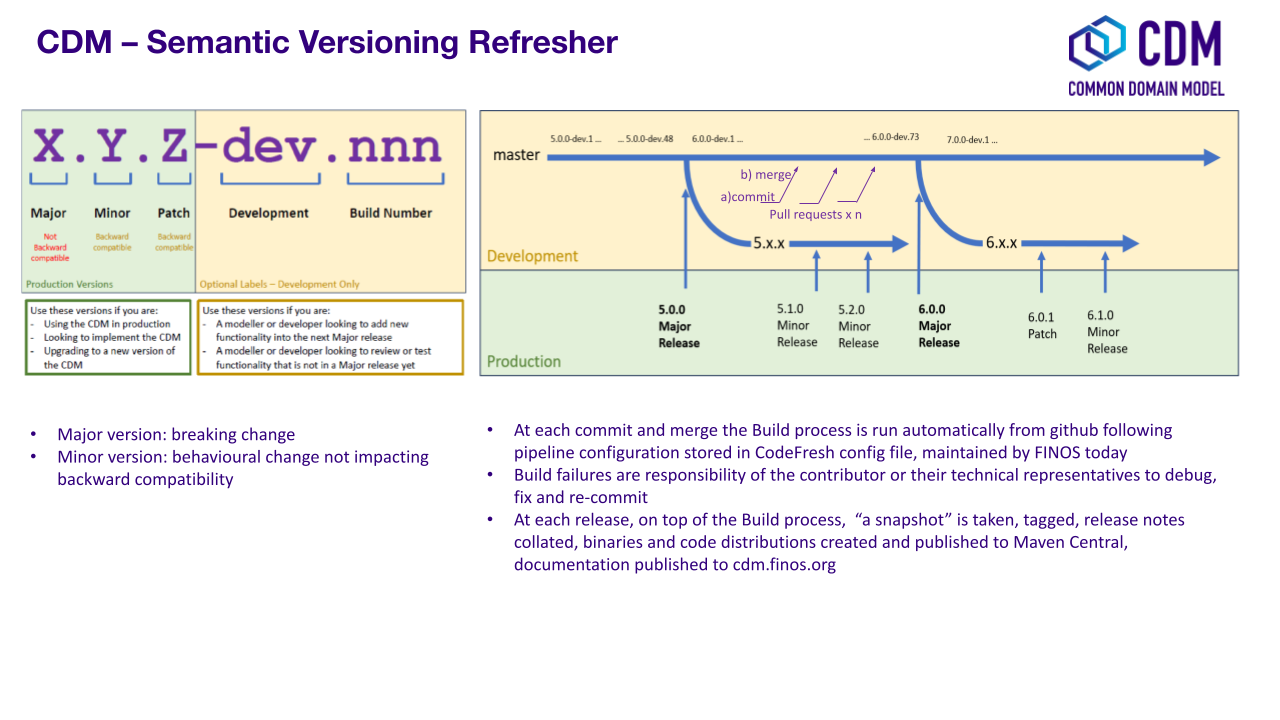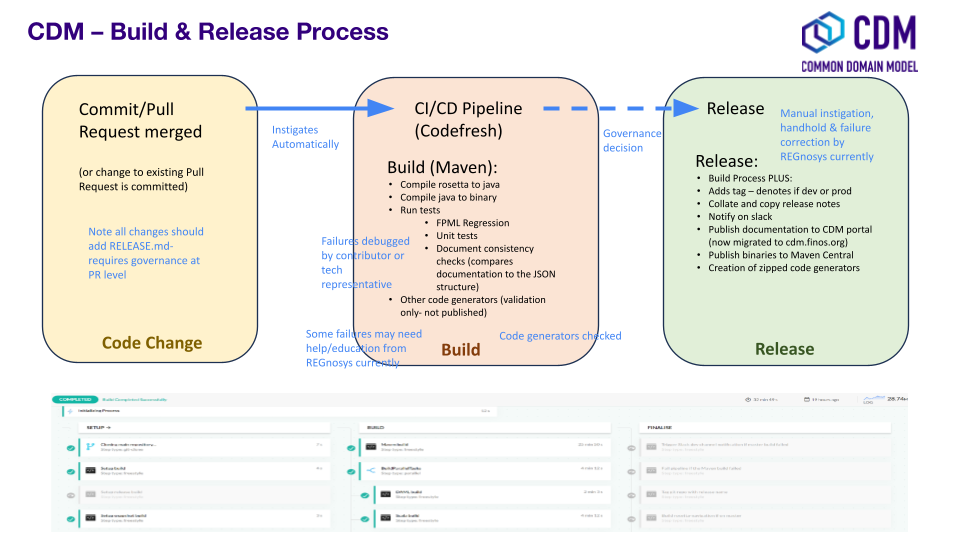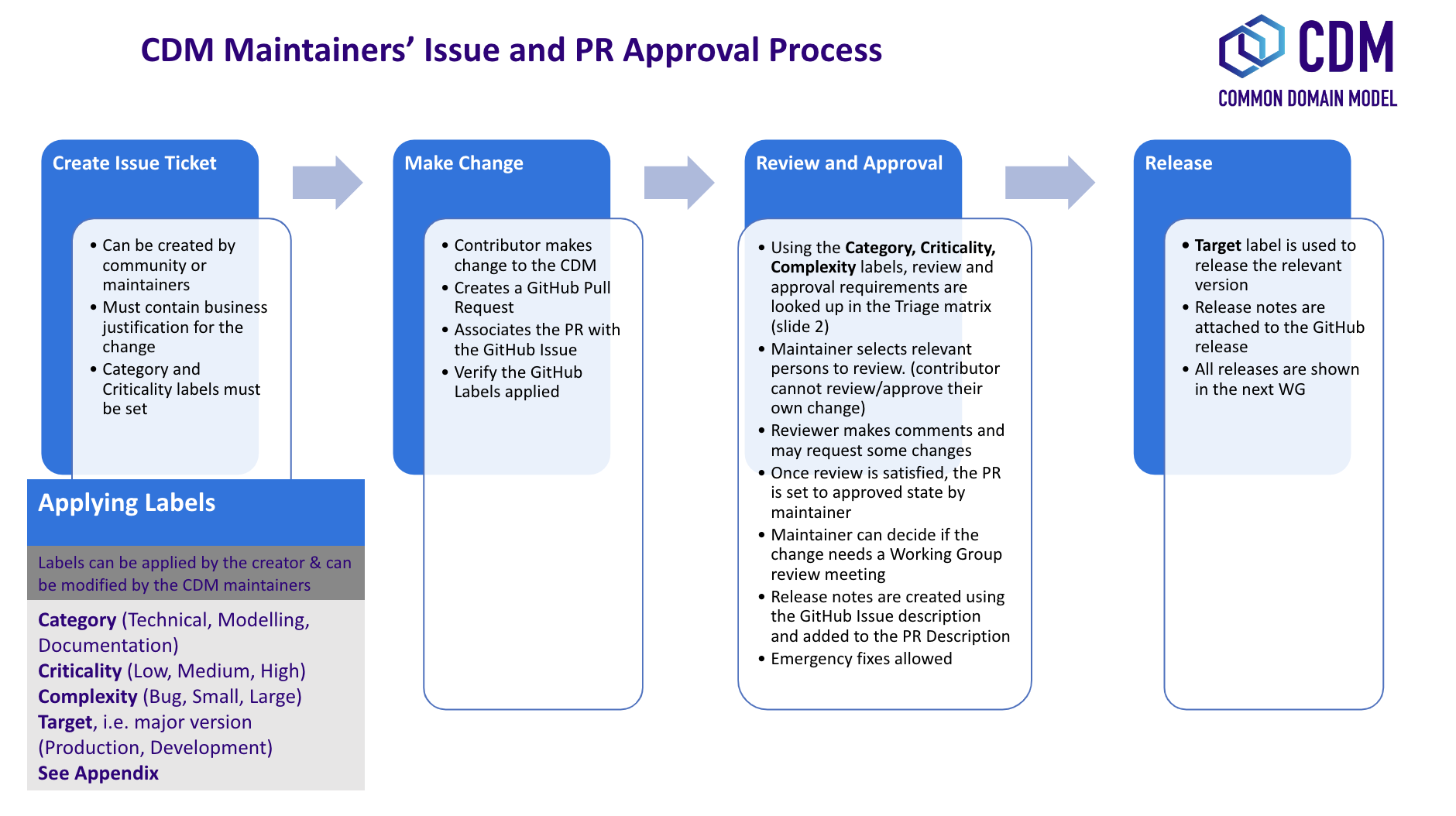Development Guidelines
This page will take you through how to contribute to the CDM, the necessary steps to take before you contribute, as well as how to edit and test your changes.
CDM Development Guidelines
The CDM Development Guidelines are defined by the Steering Working Group. The full set of CDM development guidelines for how contributions are reviewed can be found here.
Roles
The CSL specifies three different contribution roles for each specific working group:
- Maintainers - those who drive consensus within the working group
- Editors - those who codify ideas into a formal specification
- Participants - anyone who provides contributions to the project under a signed CSL CLA. A great way to sign the CLA is to open a Pull Request to add your name to the participants file.
CDM Design Principles
Contributions to the CDM have to comply with the set of design principles that include the following concepts:
- Normalisation through abstraction of common components
- Composability where objects are composed and qualified from the bottom up
- Mapping to existing industry messaging formats
- Embedded logic to represent industry processes
- Modularisation into logical layers, using namespace organisation
Version Management
The CDM is developed, built and released using standard software source-control management. Each new released version is announced to users via a release note that describes the change introduced by that new version. The CDM release history is available in the Release Section of the CDM documentation.
 Information on semantic versioning, backwards compatibility and version availability can be found here.
Information on semantic versioning, backwards compatibility and version availability can be found here.
Backward Compatibility
Like other types of software, backward compatibility in the context of a domain model means that an implementor of that model would not have to make any change to update to such version.
- Prohibited changes:
- Change to the structure (e.g. the attributes of a data type or the inputs of a function) or removal of any model element
- Change to the name of any model element (e.g. types, attributes, enums, functions or reporting rules)
- Change to any condition or cardinality constraint that makes validation more restrictive
- Change to the DSL that results in any existing expression becoming invalid
- Change to the DSL that results in change to any of the generated code's public interfaces
- Allowed changes:
- Change that relaxes any condition or cardinality constraint
- Change to any synonym that improves, or at least does not degrade, the mapping coverage
- Addition of new examples or test packs
- Change to the user documentation or model descriptions
- Addition of new data types, optional attributes, enumerations, rules or functions that do not impact current functionality
Exceptions to backward compatibility may be granted for emergency bug fixes following decision from the relevant governance body.
Agile Development Approach
The on-going development of the CDM adheres to a methodology inspired by the Agile software development framework. This methodology is based on two high-level principles:
- Focus on business value from the user's perspective, encapsulated in the concept of user story
- Delivery of small, releasable changes that contribute to that business value (sometimes referred to as shippable increments) - i.e. no "big bang" changes
To learn more, visit our development approach page.
How to Contribute
The purpose of this section is to provide guidance for submitting, reviewing and releasing changes to the CDM contributed by the wider industry community including market participants, trade associations and technology or service vendors. It describes:
- What a Contributor should do to edit and contribute changes to the CDM
- What a Maintainer should do to review the changes
- How to release a new CDM version once changes have been approved
Development of the CDM is supported through various modelling platforms, including Rosetta and Legend. Regardless of the modelling platform used, modelling and contribution to the CDM should go through the contribution check-list below.
The steps required to change the CDM are aligned with the software development lifecycle typically applicable to the development of any other software. This development lifecycle is illustrated in the diagram below. Each step is associated to the relevant component of the Rosetta platform that can be used to support the development of the CDM.

Note: This documentation is not an endorsement of any modelling platform and associated products and CDM users remain invited to leverage the tools of their choosing. This contribution guide has been contextualised with references to Rosetta to ease understanding and align with the current process.
Before you start modelling
Before you start modelling, please make sure you have gone through the following pre-modelling checklist:
- Review the design principles and the governance page.
- Review the Rosetta Starter Guide or equivalent in your chosen modelling platform.
In addition, for large model changes or changes to core data types, it is recommended that the Contributor reviews the agile development approach and follows these steps:
- Define use case. Identify and document one or more use cases with details (e.g. a sample trade).
- Draft conceptual design (high level). Draft a conceptual view showing the set of data types, their definitions (and/or sample attributes but not the whole set of attributes), their relationships to each other, and, if applicable, a workflow.
- Design approval. Obtain approval of high-level conceptual design
from CDM stakeholders:
- CDM Owners (FINOS and other involved Trade Associations, where applicable)
- CDM Sub-Working Group, if applicable
- CDM Architecture and Review Committee
- Quality assurance. Seek the early appointment of at least one CDM Maintainer who can assist modelling discussions and provide early feedback. CDM Maintainers are appointed by the CDM Owners as and when relevant. Please contact cdm@lists.finos.org.
Note: Unless explicitly instructed by a CDM Maintainer, a Contributor can only ever develop changes to a development (i.e. pre-release) version of the CDM.
Editing the model
Please refer to the editing section which covers editing the model in more detail.
Testing
The CDM has adopted a test-driven development approach that maps model
components to existing sample data (e.g., FpML documents or other
existing standards). Mappings are specified in the CDM using synonym
which are collected into a Translation Dictionary, and the sample data
are collected into a Test Pack. Each new model version is
regression-tested using those mappings to translate the sample data in
the Test Pack and then comparing against the expected number of mapped
data points, validation and qualification results.
When using Rosetta to edit the model, contributors are invited to test their model changes live against the Test Pack using the Rosetta Translate application, referring to the Rosetta Translate Guide. When editing existing model components, the corresponding synonyms should be updated to maintain or improve existing mapping levels. When adding new model components, new sample data and corresponding synonym mappings should also be provided so the new use-case can be added to the set of regression tests.
Please refer to the Mapping Guide for details about the synonym mapping syntax.
Namespace
All model components should be positioned appropriately in the existing namespace hierarchy. If the proposed contribution includes changes to the namespace hierarchy, those changes should be justified and documented. Any new namespace should have an associated description, and be imported where required.
Please refer to the namespace section for more details.
Contributing
Changes are contributed by submitting a Pull Request for review into the CDM source-control repository. This pull request will invoke a build process to compile and run all CDM unit tests and regression tests.
Given the alignment:
1 pull request = 1 contribution = 1 releasable unit = 1 user story,
we recommend labelling the pull request with the user story label, i.e. "STORY-XYZ: ..." to facilitate its tracking.


Note: All contributions are submitted as candidate changes to be incorporated under the CDM licence.
When using Rosetta to contribute model changes, the contribution interface allows to specify a title and description for the contribution. Those inputs are used to create a Pull Request on a one-off branch in the source-control repository. Please refer to the Rosetta Workspace Contribution Guide for more information.
Note: It is not yet possible to contribute updated test expectations, documentation, release notes or new sample data using Rosetta, so these must be provided to the CDM Maintainers via Slack or email.
Documentation
The CDM documentation must be kept up-to-date with the model in production. Where applicable, the Contributor should provide accompanying documentation (in text format) that can be added to the CDM documentation for their proposed changes.
The documentation includes code snippets that directly illustrate explanations about certain model components, and those snippets are validated against the actual model definitions. When a model change impacts those snippets, or if new relevant snippets should be added to support the documentation, those snippets should be provided together with the documentation update.
Release note
A release note should be provided with the proposed model change that concisely describes the high-level conceptual design, model changes and how to review. Please refer to the content of release notes for further guidance on editing release notes.
Reviewing model changes
Review checklist
Before starting to review a contribution, the CDM Maintainer should go through the following review checklist:
- Review Pull Request to assert that:
- Model changes fulfil the proposed design and use-case requirements
- Synonyms have been updated and output (JSON) looks correct
- Contributed model version is not stale and does not conflict with any recent changes
- Changes are in accordance with the CDM governance guidelines
Note: It is not yet possible to verify that mapping, validation and qualification expectations have been maintained by looking at the output of the Pull Request and CDM build only. Please refer to the downstream dependencies section for more details.
- CDM build process completed with no errors or test failures
- Review additional samples provided (if use-case is not covered by existing samples)
- All model components positioned in the correct namespace
- All model components have descriptions
- Additional documentation provided, if necessary.
- Release note provided
Any review feedback should be sent to the Contributor as required via Slack, email or in direct meetings.
Note: Depending on the size, complexity or impact of a contribution, the CDM Maintainer can recommend for the contribution to be presented with an appropriate level of details with the CDM Architecture and Review Committee for further feedback. The CDM Maintainer will work with the Contributor to orchestrate that additional step. The additional feedback may recommend revisions to the proposed changes. When it is the case the review process will iterate on the revised proposal.
Model maintenance
Before the Pull Request can be merged into the CDM's main branch, some work is usually required by the Maintainer to preserve the integrity of the model source code and of its downstream dependencies.
Post-review technical tasks
A number of technical tasks may need to be performed on the Pull Request once it is approved:
- Stale CDM version: Contribution is based on an old CDM version and model changes conflict with more recent changes. If the conflicting change is available in Rosetta, the contributor should be asked to update their contribution to the latest version and resubmit. If the conflicting change is not yet available in Rosetta, this merge will need to be handled by the CDM Maintainer.
- Failed unit tests: Java unit tests in the CDM project may fail due to problems in the contributed changes. Alternatively it may be that the test expectations need to be updated. The Maintainer should determine the cause of the test failure and notify either the Contributor or work on adjusting the test expectations.
- Additional documentation: If the contributor provided additional documentation, the Maintainer should update the CDM documentation by editing the documentation.rst file in GitHub.
- Documentation code snippets: To avoid stale documentation, the CDM build process verifies that any code snippets in the documentation exists and is in line with the model itself. The Maintainer should adjust or include any code snippets by editing the documentation.rst file on GitHub.
- Code generation: Model changes may cause code generator failures (e.g., Java, C#, Scala, Kotlin etc.). In the unlikely event of code generation failures, these will need to be addressed by the Maintainer.
Downstream dependencies
The CDM has a number of dependent projects that are required for the model to be successfully distributed. It is possible that model changes may cause these downstream projects to fail. The Maintainer will need to test and, if necessary, update those before the changes can be released.
- Translate: The regression tests in this project compare the contributed model against the expected number of mapping, validation and qualification results. Due to the contributed model changes, it is likely that there will be expectation mismatches that cause this build to fail.
- CDM Homepage: compile and test.
- CDM Java Examples: compile and test.
Note: In most cases, the post-review technical tasks and downstream dependencies require software engineering expertise in addition to CDM expertise. Additional technical support from the CDM Maintainer team may need to be called upon to address those.
The change can be merged into the main CDM code base only upon:
- approval by CDM Maintainers and/or CDM Architecture and Review Committee,
- successful completion of all the above technical tasks, and
- successful builds of the CDM and all its downstream dependencies.
Releasing model changes
Once the contributed model change has been merged, a new release can be built, tested and deployed. The Maintainer will work with the CDM Owners and the Contributor on a deployment timeline.
The following release checklist should be verified before deploying a new model:
- Update the CDM version number, using the semantic versioning format
- Build release candidate, and test
- Build documentation website release candidate, and test
- Deploy release candidate and notify channels if need be
- (Currently done at a later stage) Update the latest CDM version available in Rosetta

Note: When the release process is handled through Rosetta Deploy, the Maintainer should contact the Rosetta support team to request that deployment and discuss a timeline for the release.
Documentation Style Guide
This section provides form and substance recommendations for editors of CDM documentation. Please visit the documentation style guide page to learn more.
Contribution via Rosetta
The Rosetta Design application can be used to contribute to the CDM without setting up any development environment. Rosetta Design’s source control integration means that a PR is automatically created to a fork of the FINOS CDM under the Rosetta Models GitHub Organisation.
Steps:
- Create a Workspace for the CDM in Rosetta Design
- Review and contribute change in Rosetta Design - which will create PR in the rosetta-models organisation
- Create a PR to the Finos Github. See instructions here
When using Rosetta to contribute model changes, the contribution interface allows to specify a title and description for the contribution. Those inputs are used to create a Pull Request on a one-off branch in the source-control repository. Please refer to the Rosetta Workspace Contribution Guide for more information.
Contributing via GitHub
- Fork it (https://github.com/finos/common-domain-model)
- Create your feature branch (
git checkout -b feature/my-new-feature) - Make a change - hint you can make changes to Rosetta files directly on your desktop using the Rosetta VS Code plugin
- Read our contribution guidelines and Community Code of Conduct
- Commit your changes (
git commit -am 'My New Feature') - Push to the branch (
git push origin feature/my-new-feature) - Create a new Pull Request
Note: It is not yet possible to contribute updated test expectations, documentation, release notes or new sample data using Rosetta, so these must be provided to the CDM Maintainers via Slack or email.
Documentation
The CDM documentation must be kept up-to-date with the model in production. Where applicable, the Contributor should provide accompanying documentation (in text format) that can be added to the CDM documentation for their proposed changes.
The documentation includes code snippets that directly illustrate explanations about certain model components, and those snippets are validated against the actual model definitions. When a model change impacts those snippets, or if new relevant snippets should be added to support the documentation, those snippets should be provided together with the documentation update.
Release note
A release note should be provided with the proposed model change that concisely describes the high-level conceptual design, model changes and how to review. Please refer to the content of release notes for further guidance on editing release notes.
- Update the CDM version number, using the semantic versioning format
- Build release candidate, and test
- Build documentation website release candidate, and test
- Deploy release candidate and notify channels if need be
- (Currently done at a later stage) Update the latest CDM version available in Rosetta

Note: When the release process is handled through Rosetta Deploy, the Maintainer should contact the Rosetta support team to request that deployment and discuss a timeline for the release.
Next Steps
Please visit the maintenance page to continue reading about model maintenance and release.
